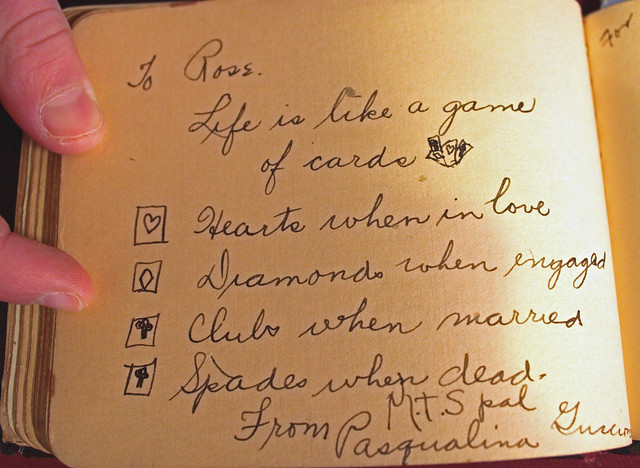
Yesterday we took a look at Rose Simone's Manhattan Trade School autograph book and then examined the report card of one of the students who had signed that book, Jennie Grillo. Today we're going to look at the student file of another student who signed Rose's autograph book, Pasqualina Guccione. Her note in Rose's book is shown above.
Pasqualina Guccione's student record is part of my collection. Unfortunately, her report card, like Jennie Grillo's, does not include a photograph, so we don't know what she looked like. But her story appears to have been an interesting one. Let's start with her main card (for all the images in today's entry, you can click to enlarge):
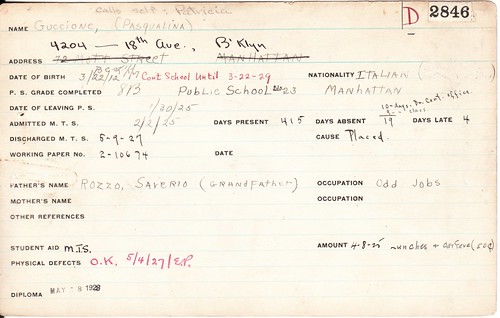
There are a few points of interest here. First, Pasqualina apparently preferred to be called Patricia. But she used Pasqualina when signing Rose's book, so I think I'll continue to refer to her as Pasqualina. Second, Pasqualina lived with her grandfather, Saverio Rozzo, not with her parents. Were they deceased?
But the most interesting thing about this card is the indication, toward the bottom, that Pasqualina received financial assistance from the school — "Lunches & carfare (50¢)." Student aid, based on hardship or need, was available to all Manhattan Trade School students but was usually granted only if the student's family was going to pull her out of school so she could work to help support the household. This apparently didn't come up very often, because very few of the report cards in my collection have any notations relating to the aid program. Because financial aid was granted to Pasqualina, however, her student record includes a series of forms and entries not found in most of the other students' files, beginning with this card from the school's financial aid office:
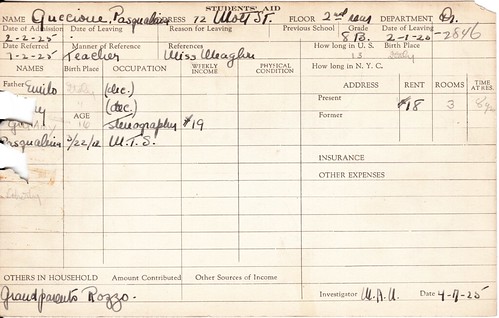
From this card we can see that Pasqualina's parents were indeed deceased (as indicated by the "dec." notations in the "Occupation" column). She lived not just with her grandfather but with both of her grandparents, along with an older sister who was working as a stenographer. She was referred for student aid by one of her teachers, Miss Meaghre. The card also indicates that Pasqualina was born in Italy, which makes her something of a rarity among the Manhattan Trade students I've investigated, most of whom were born in New York to immigrant parents. At the bottom-right corner of this card are the initials of an "Investigator" — M.A.U. This was apparently the financial aid case worker who was assigned to Pasqualina after she was referred to the aid office by her teacher. I'm fairly certain that that it was M.A.U. who wrote the fascinating entries that appear on the following cards:
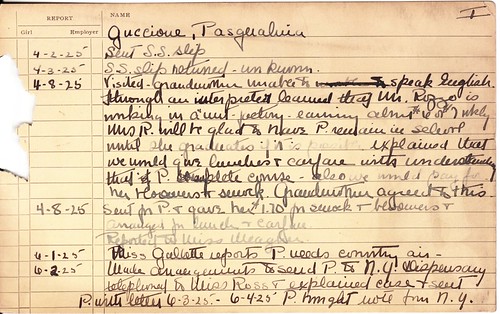
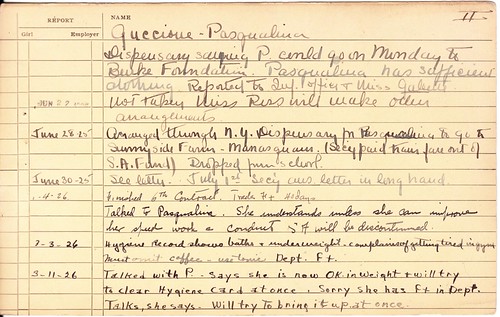
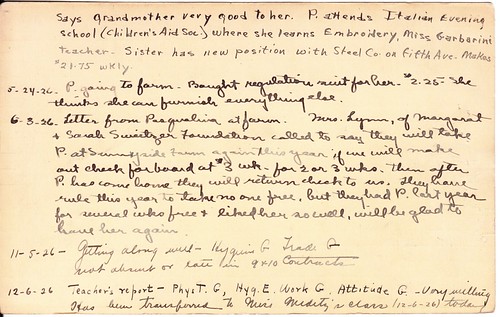
Cards like these do not appear in most of the student files in my collection. They only appear in Pasqualina's because she received financial aid. The handwriting is a little hard to make out, so here's a transcription (for the sake of clarity, I've spelled out a few terms that were abbreviated and added a few annotations):
April 2, 1925: Sent S.S. slip.Wow — that's quite a narrative. It really shows how the school kept close tabs on everything relating to a student who was receiving financial aid — her home life, her schooling, her health. I'm fairly certain the school was concerned about these aspects of every student who attended Manhattan Trade, but only the students receiving financial assistance had all of these details documented in so much detail.April 3, 1925: S.S. slip returned — unknown. [I don't know what this "S.S. slip" refers to. It definitely doesn't have anything to do with Social Security, which didn't yet exist in 1925. — Paul]
April 8, 1925: Visited grandmother [who was] unable to speak English. Through an interpreter learned that Mr. Rozzo [Pasqualina's grandfather] is working in a nut factory, earning about $6 or $7 weekly. Mrs. Rozzo will be glad to have Pasqualina remain in school until she graduates if it is possible. Explained that we would give lunches and carfare with understanding that Pasqualina complete course. Also, we would pay for her bloomers and smock. Grandmother agreed to this. [The bloomers and smock were likely part of either the school uniform or the togs that would be worn during gym class. Both can be seen in this amazing 1912 film about the school. — Paul)
April 8, 1925: Sent for Pasqualina and gave her $1.70 for smock and bloomers and arranged for lunch and carfare. Reported to Miss Meaghre.
June 1, 1925: Miss Gallette reports Pasqualina needs country air. [It was fairly common during this period for girls and women suffering from "exhaustion" or "a nervous condition" to be recommended for a "rest cure" outside the city. That appears to be what was happening here with Pasqualina. — Paul]
June 2, 1925: Made arrangements to send Pasqualina to N.Y. Dispensary. Telephoned to Miss Ross and explained case and sent Pasqualina with letter. [The New York Dispensary was a philanthropic medical service. Further info here. — Paul]
June 4, 1925: Pasqualina brought note from N.Y. Dispensary saying she could go on Monday [June 8] to Burke Foundation [which was another philanthropic medical facility — Paul]. Pasqualina has sufficient clothing. Reported to [illegible] and Miss Gallette.
June 22, 1925: Not taken. Miss Ross will make other arrangements.
June 28, 1925: Arranged through N.Y. Dispensary for Pasqualina to go to Sunnyside Farms, Manasquan. Secretary paid train fare out of student aid fund. Dropped from [illegible]. [Sunnyside Farms was a "respite home for convalescent girls" in Manasquan, New Jersey. You can get a sense of the accommodations from this 1951 postcard, which shows one of the bedrooms. The facility now functions as a nursing home. — Paul]
June 30, 1925: See letter.
July 1, 1925: Secretary [illegible] letter in longhand. [Unfortunately, this letter was not included in Pasqualina's student file. — Paul]
Jan. 4, 1926: Finished 6th contract. Trade F+ 40 days. [This means Pasqualina had finished her sixth unit of coursework at the school and had received a grade of F+ — a bit better than fair. — Paul] Talked to Pasqualina. She understands that unless she can improve her school work and conduct, student aid will be discontinued.
March 3, 1926: Hygiene record shows baths and underweight. Complains of getting tired in gym. Must omit coffee — use tonic. Deportment: F+.
March 11, 1926: Talked with Pasqualina. Says she is now OK in weight and will try to clear hygiene card at once. Sorry she has F+ in Deportment. Talks, she says. Will try to bring [the grade] up at once. Says grandmother very good to her. Pasqualina attends Italian evening school (Children's Aid Society), where she learns embroidery. Miss Garbarini [is her] teacher. Sister has new position with Steel Co. on Fifth Ave. Makes $21.75 weekly. ¬
May 24, 1926: Pasqualina going to farm. Bought regulation suit for her — $2.25. She thinks she can furnish everything else. [The farm is Sunnyside Farms, the same facility Pasqualina had visited the previous summer. — Paul]
June 3, 1926: Letter from Pasqualina at farm. Mrs. Lynn, of the Margaret and Sarah Switzer Foundation [the philanthropy that operated Sunnyside Farms], called to say they will take Pasqualina at Sunnyside Farms again this year if we will make out a check for board at $3 a week for two or three weeks. Then, after Pasqualina has come home, they will return check to us. They have a rule this year to take no one [for] free, but they had Pasqualina last year for several weeks [for] free and liked her so well, [so they] will be glad to have her again.
Nov. 5, 1926: Getting along well — Hygiene Good, Trade Good. Not absent or late in contracts 9 and 10.
Dec. 6, 1926: Teacher's report: Physical Training Good, Hygiene Excellent, Work Good, Attitude Good. Very willing. Has been transferred to Miss Meditz's class today.
Okay, back to Pasqualina's student record. Next up are her grades (several of which were referenced in the financial aid notes) and teachers' comments:

As you can see, Pasqualina's grades and teacher feedback were generally good, although there's a note about her being "talkative," which matches up with that earlier note about her chatty deportment.
Pasqualina, like all Manhattan Trade students, had to demonstrate proficiency in her trade (dressmaking) before she could receive her diploma, so the school's job placement office arranged some work for her. Here's her work record, along with comments from her employers:

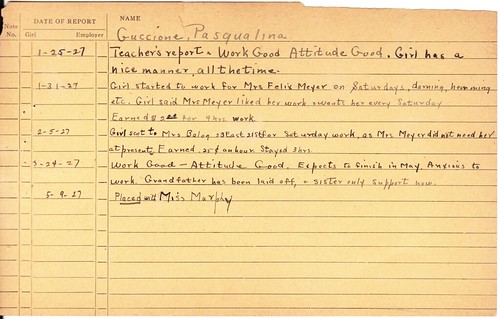
Nothing unusual here, except for the troubling note on March 4, 1927, that Pasqualina's grandfather had been laid off from his job, leaving her older sister as the family's sole means of financial support.
That's the end of Pasqualina's student record. The only other thing we know about her is the cheery note she left in Rose Simone's autograph book.
If Pasqualina is still alive, she'll be celebrating her 102nd birthday later this month. Realistically, though, she's probably deceased. My research assistants and I haven't previously tried to track down her descendants, or those of Jennie Grillo (the student whose record we looked at in yesterday's entry), but we may have to do some digging on them now, thanks to their connection to Rose's autograph book. Stay tuned.
Pasqualina's and Jennie's report cards have been in my collection for years, but I had never taken a close, detailed look at them until now. Why? A big part of it is because their cards didn't include photographs — the non-photo cards seem inherently less interesting, less inviting, than the photo-inclusive cards. Also, we've largely concentrated on some of the students who would now be "younger" — i.e., in their 90s — in the hopes of finding one who's still alive. (We succeeded in that regard once.)
Really, though, a lot of it is just a matter of the large number of student records in my collection (nearly 400) and the limited amount of time and resources for examining and investigating them. In this case, there was a bonus connection — Jennie's and Pasqualina's notes in Rose Simone's autograph book. That provided the impetus to pull out Jennie's and Pasqualina's report cards and give them a closer look.
I wish I had Rose's report card as well. I'm super-grateful to her granddaughter, Sara Dunphy, for contacting me and sending me photos of the pages from the autograph book. She also sent me Rose's lovely graduation photo, which shows her holding her Manhattan Trade School diploma:
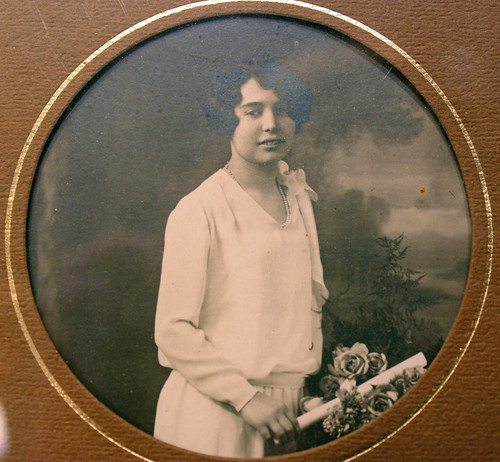
Sara also sent one additional photo — a family shot of Rose (center), Sara (top), and Sara's children. The photo was taken a month before Rose's death at the age of 102:

Thanks again for everything, Sara. And Rose, RIP.

Paul, the teacher's name you could not decipher is not "Uleagher" - I'm pretty sure the Student Aid card says "Meaghre", based on the capital Ms in "Miss" and in "Mott St". The April 8 entry spells it as "Meagher". Additionally, the first three entries on the report card are attributed to "A. Meagher" in more legible handwriting.
ReplyDeleteSure enough, some Googling turns up an Alice C. Meagher who was hired at the Manhattan Trade School as an elementary dressmaking teacher in 1923. First story at this (slow) link: http://fultonhistory.com/Newspaper%2018/New%20York%20NY%20Sun/New%20York%20NY%20Sun%201923/New%20York%20NY%20Sun%201923%20-%201221.pdf
Ah, excellent work -- I'll update the text accordingly. Thank you!
DeleteTo me it looks like the financial aid case worker offered to pay for "bloomers & smock", in addition to lunches and carfare, and Pasqualina was given $1.70 for the same. I'm assuming they had some sort of student uniform?
ReplyDeleteYes -- good deciphering!
DeleteI judging by photos and old film footage that I've seen, I don't think the school had a uniform. But the girls did wear bloomers (and, I guess, something that could be considered a smock) for phys ed classes. So that's likely what this was for.
Thanks, Andrea!
Wait, I take that back -- might have been a uniform after all. I'll update text accordingly!
Delete